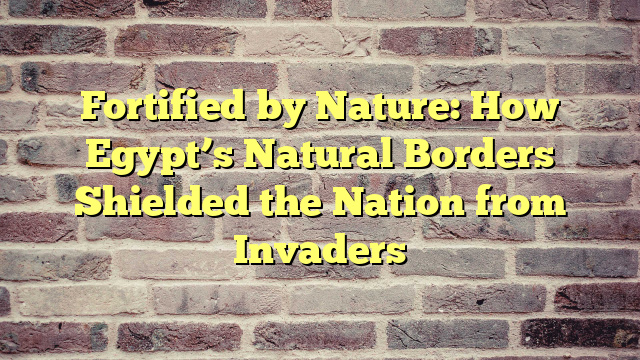Fortified by Nature: How Egypt’s Natural Borders Shielded the Nation from Invaders
“`html
Fortified by Nature: How Egypt’s Natural Borders Shielded the Nation from Invaders
Egypt, a cradle of civilization, has been a focal point of cultural and strategic importance for millennia. Its unique geographical location and natural borders have played a pivotal role in shaping its history. These natural defenses have fortified Egypt against numerous invasions, allowing it to develop a rich and enduring culture. This article explores how Egypt’s natural landscapes acted as formidable barriers against would-be conquerors.
The Geographical Shield
Egypt’s geography is marked by several natural barriers that have protected it from external threats. These include deserts, seas, and rivers, each serving as a natural fortification against invasion.
The Deserts
The vast deserts surrounding Egypt have been its primary defense. The Eastern and Western Deserts, inhospitable and treacherous, have deterred armies from attempting to cross into Egyptian territory.
- The Eastern Desert: Stretching between the Nile and the Red Sea, this desert served as a barrier to the east, protecting Egypt from invasions from Asia.
- The Western Desert: Covering a vast area west of the Nile, this desert shielded Egypt from invasions from North Africa.
The Mediterranean Sea and the Red Sea
To the north, the Mediterranean Sea provided a natural barrier, while the Red Sea to the east further secured the nation from maritime invasions. These water bodies required would-be invaders to possess advanced naval capabilities, limiting the number of potential threats.
The Nile River
The Nile River, Egypt’s lifeline, also served as a strategic barrier. Its annual floods made crossing difficult for enemy armies, and its length provided a natural moat that protected the interior of Egypt.
Historical Instances of Protection
Throughout history, Egypt’s natural borders have played a crucial role in its defense against various empires and armies.
Protection from the East
The Eastern Desert’s harsh terrain prevented large-scale invasions from the east. Notably, it limited the incursions of the Asiatic peoples and later the Persians, forcing them to take sea routes that could be more easily defended.
Defense Against the West
The Western Desert was equally formidable. It acted as a deterrent against the expansion of Roman and later Arab forces, slowing their advances and allowing Egypt to prepare its defenses.
Naval Defense
The Mediterranean and Red Seas were natural barriers that protected Egypt from naval invasions. The famous Battle of the Delta in 1178 BCE saw the Egyptians repelling a sea invasion by the Sea Peoples, showcasing the strategic advantage provided by the Mediterranean Sea.
The Impact of Natural Borders on Egyptian Society
The natural fortifications not only protected Egypt from invasions but also influenced its society, economy, and culture.
Economic Prosperity
Security from invasion allowed Egypt to develop a strong economy based on agriculture, trade, and innovation. The Nile, in particular, supported agriculture, which was the backbone of Egypt’s economy.
Cultural Development
Isolation provided by natural borders fostered a unique culture, with advancements in art, science, and religion. The stability allowed for the construction of monumental architecture, such as the pyramids and temples, which remain symbols of Egypt’s enduring legacy.
Political Stability
The protection afforded by natural landscapes contributed to political stability, allowing dynasties to focus on governance, infrastructure, and the well-being of their citizens rather than constantly defending against invasions.
Conclusion
Egypt’s natural borders have been a significant factor in its historical resilience and cultural development. The deserts, seas, and the Nile River provided natural defenses that shaped the course of Egyptian history, protecting it from invaders and fostering a unique civilization that continues to fascinate the world. As we look back, it’s clear that nature played a pivotal role in fortifying this ancient nation, allowing it to thrive amidst a tumultuous regional landscape.
| Natural Barrier | Direction | Role in Defense |
|---|---|---|
| Eastern Desert | East | Protection from Asian invasions |
| Western Desert | West | Protection from African invasions |
| Mediterranean Sea | North | Naval defense barrier |
| Red Sea | East | Naval defense barrier |
| Nile River | Throughout Egypt | Natural moat and resource for sustenance |
“`

